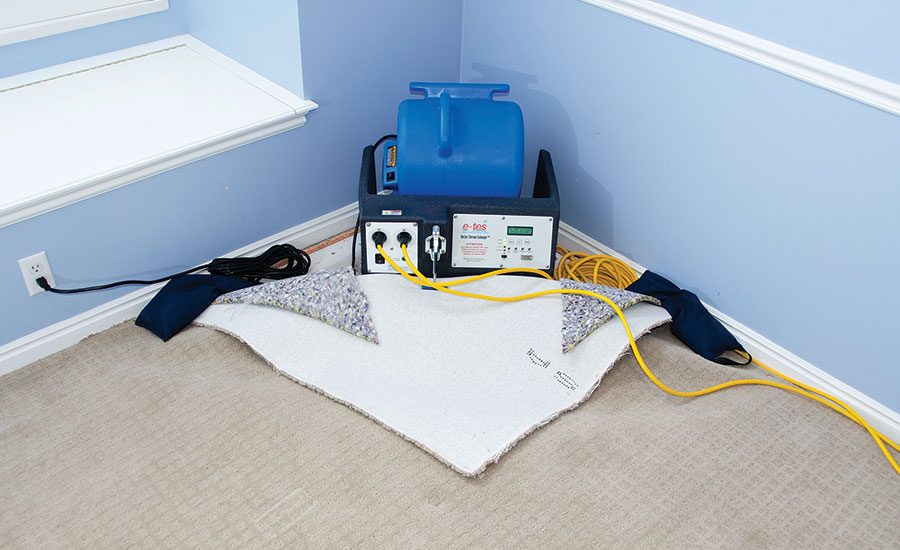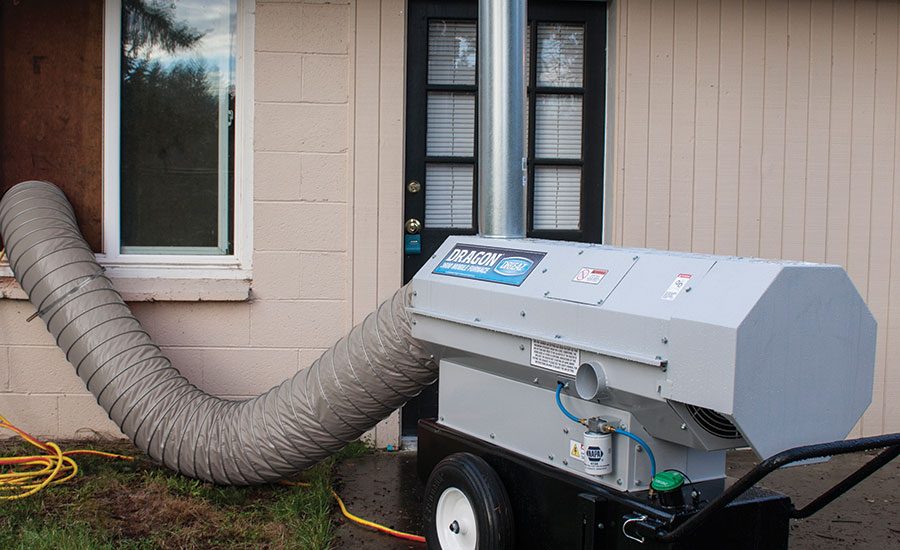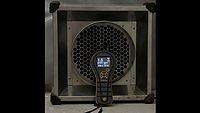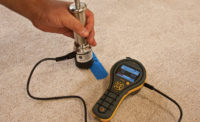In the structural drying industry, all drying utilizes heat drying in some form or another. Energy is required to clear the latent heat of vaporization—that is, the amount of energy necessary to convert a liquid into a gas. Although this IS why we use heat drying, theory alone does not contextualize the technique. The equipment and effectiveness of heat drying have been hotly debated over the years, and it may be time to properly frame what we mean by “heat drying.”
Our industry has come a long way with equipment in its history. Despite all of the improvements in extractors, air movers, and dehumidifiers, the evaporation process remains the bottleneck. When the molecules escape a wet surface (liquid) in a phase and change to vapor (gas), it takes energy (heat) with it. This cools the surface making it harder for more molecules to change phases. Eventually, evaporation ceases or slows so much that no practical progress is made. Restoration contractors need to make sure that doesn’t happen, so what do they do? We are forced to continuously add energy back to counteract the cooling effect of evaporation until all of the excess moisture is removed. Traditionally, we’ve added dehumidifiers that are producing hot/dry air and air movers to transfer energy into the wet materials (liquid).
Heat drying accelerates this energetic tug of war for the contractor; if a little heat from dehumidifiers, the HVAC, and the air movers is good, then more would be better, right? We are limited by the ignition point of the materials—or more practically by an industry agreed to guideline of air temperatures not exceeding 105ºF. (For more information, download the RIA Safe Harbor Guidelines at restorationindustry.org)
How much heat is enough? There are a lot of formulas, scientific jargon, and “rules of thumb” used to explain if you are set up to effectively dry. I’ve heard and presented those in the past and watched eyes glaze over when technicians hear that “brilliance.” To simplify it for practical field use, one should be able to determine if they are evaporating and how well they are doing by measuring two simple items.
Measure the dew point of the air. If that’s not on your hygrometer, there are plenty of simple calculators to convert air temperature and relative humidity (RH%). Next, measure the surface temperature of the wet material with an infrared camera or a simple infrared thermometer (some hygrometers have these built in). Remember this rule: the bigger one wins! If the surface temperature is greater than the dew point of the air, you are evaporating (water molecules are leaving the surfaces). The bigger that difference, the better you are evaporating. If, however, the dew point of the air is greater, you are condensing water molecules onto the surfaces. There are only two ways that you can improve the evaporation rate: 1. Dehumidify the air more to lower the dew point and/or 2. Heat the wet surface more.
Some of the industry debate is centered on HOW to produce and deliver the heat/energy to promote faster evaporation. There are several methods, machines, and fuel sources from which to choose. The list includes the following types of heaters: direct fired, indirect fired, hydronic, electric, and infrared. Besides electricity, they can also be fueled by natural gas, propane, kerosene, or fuel oil. Safety is always the first concern using any equipment. Heating equipment can have concerns that other drying equipment doesn’t: carbon monoxide emissions, excessive heat that could ignite materials, fuel spills/leaks, and open flames. These need to be controlled by personnel and built-in safety sensors and equipment.
I have been asked over and over, “Aren’t all heating units the same? Don’t you just need the one with the highest BTU rating?” My answers to those are, “Yes, in that they all heat,” and “Not necessarily.” Is that perfectly clear? Probably not, so let me explain by concentrating on the second question.
Delivering the heat/energy to the water to promote faster evaporation, to me, is about efficiency. How fast, energy efficient, and cost effective can I be? I could use the largest heater in the world to heat a small bathroom, but should I? There would be a lot of wasted energy and fuel just to start up a unit like that. A small electric unit may be sufficient to take care of it.
A scenario that I developed and tested years ago may be helpful to explain what I’m saying. If you had two identical pots containing water and you wanted to evaporate all the water using a typical household range, which would be better? Would you put the pot on the top of the stove set to high or place it in the pre-heated oven at 500ºF? Five hundred degrees is HOT and would be the first answer for many. I have completed this test several times with 500ml of water at the same starting temperature.
The pot on top of the stove takes about 24 minutes and 1,700 BTUs. The pot in the oven at 500ºF takes about 120 minutes and 16,320 BTUs. The rate of evaporation in these two situations is more sensitive to how direct the transfer is instead of how intense the heat source is. The energy was more directly transferred to the water on top of the stove. Notice, it took almost ten times the amount of energy in the oven compared to on the stove top. In the oven, the air is heated and then transferred to the pot and water. Heating the water in the materials to promote evaporation is the ultimate goal, not heating the air in the structure. With many heating systems, though, you must heat the air and then transfer that heat/energy to the wet materials (liquid water).
Efficiency needs to be balanced with the size of the project, fuel or electricity availability, cost considerations, and building security. What equipment is available? If we have a choice, what is the most efficient while balancing costs? If I have a small header that is problematic, I may choose an infrared heater. An 8,000 cubic foot crawlspace can be addressed with an indirect fired heater. An electric heater may be the best choice to use with a floor drying system for a hardwood kitchen floor.
Debate over whether heat drying works or not should be a thing of the past. By definition, all drying uses heat/energy whether you use a “heater” or not. Learn the principles of heat drying and you can apply them to almost any situation using “heat drying equipment” or the equipment you already have on the job. Want to improve your efforts? Measure the dew point of the air and the wet surface temperature. Compare and see which is greater. You want the surface temperature to be the higher number. That’s the simple version and it works well.










Report Abusive Comment